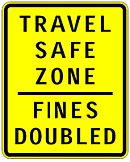907.3 Travel Safe Zones
| Worksheet |
| Travel Safe Zone Plan Worksheet |
907.3.1 Definition
A Travel Safe Zone (TSZ) is a highway safety countermeasure used to decrease crashes through increased law enforcement efforts. A TSZ allows law enforcement to issue double the normal fines for traffic violations on a segment of roadway that is designated as a TSZ. To be designated a TSZ, a highway safety analysis must demonstrate that fatal or disabling motor vehicle crashes exceed a predicted safety performance level for comparable roadways. TSZs must be clearly signed and have a specified begin date and end date to be enforced. Please see Missouri Revised Statute Section 304.590 for more information related to TSZs.
907.3.2 Signing
The TRAVEL SAFE ZONE – FINES DOUBLED sign (W26-1) grabs the attention of travelers and designates the beginning of a TSZ. Refer to Table 903.6.3 Warning Sign and Plaque Sizes to determine the proper dimensions of the TRAVEL SAFE ZONE – FINES DOUBLED sign.
The FINES DOUBLED ENDS sign (R2-20) marks the end of a TSZ. The FINES DOUBLED ENDS sign are 36 in. (wide) x 30 in. (tall).
907.3.3 Procedure
Steps:
1. Determine study/project limits. Establish a clear begin point and end point for the proposed TSZ. It is recommended to work closely with the regional Blueprint Coalition in developing the TSZ and its limits.
2. Perform a safety analysis to determine if fatal or disabling motor vehicle crashes exceed a predicted safety performance level for comparable roadways.
3. Develop a proposal to utilize the TSZ countermeasure. It is recommended to review possible engineering solutions as well as public information plans and incorporate these along with a law enforcement plan.
4. Present the completed proposal to the regional Blueprint Coalition for review. The review is recommended in order to facilitate coordination between the law enforcement plan, public information plan, and any engineering solutions (if necessary).
5. Establish a clear begin date and end date in coordination with local law enforcement and public information partners. It is recommended to utilize both law enforcement and public outreach in an effort to decrease crashes at the TSZ location.
6. Fill out the Travel Safe Zone Plan Worksheet and submit the finalized plan to Central Office Traffic and Highway Safety (Traffic Safety section). This is done for tracking purposes.
7. Order all relevant signs in preparation for the begin date of the TSZ.
8. After the TSZ has ended, conduct a review to determine the benefit of the TSZ and whether to continue using this countermeasure. Should the TSZ be continued, another plan should be developed. All relevant signs should be removed once the TSZ is determined to no longer be needed.
907.3.4 Recommendations
TSZs should have a minimum length of 1 mile.
Work closely with the regional Blueprint Coalition as support from law enforcement is an integral part of making a TSZ effective. Additionally, the traveling public needs to know this has been designated an area of concern.
Depending on the predetermined timeframe of the TSZ, the regional TSZ team (comprised of engineering, law enforcement, and public information individuals) should conduct periodic monitoring of its safety performance.
Although local ordinances are not required to install a TSZ on the state highway system when the speed limit for that portion of the highway is established by state statute, MoDOT should not discourage the use of ordinances. Each municipality shall determine whether the municipality requires a local ordinance. An ordinance may be required if the speed limit within the TSZ is already established by ordinance.

